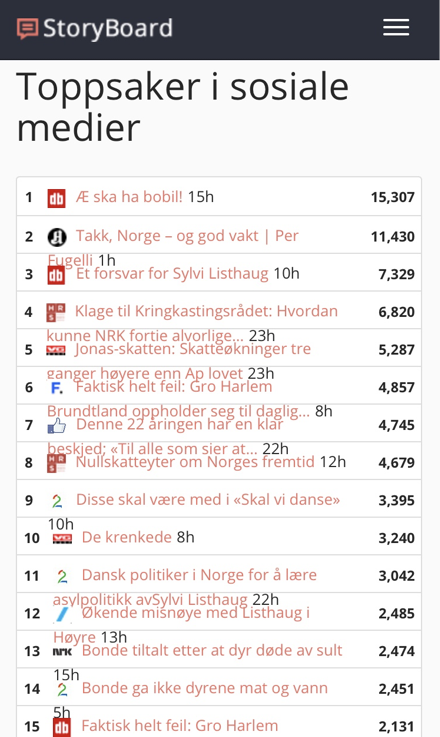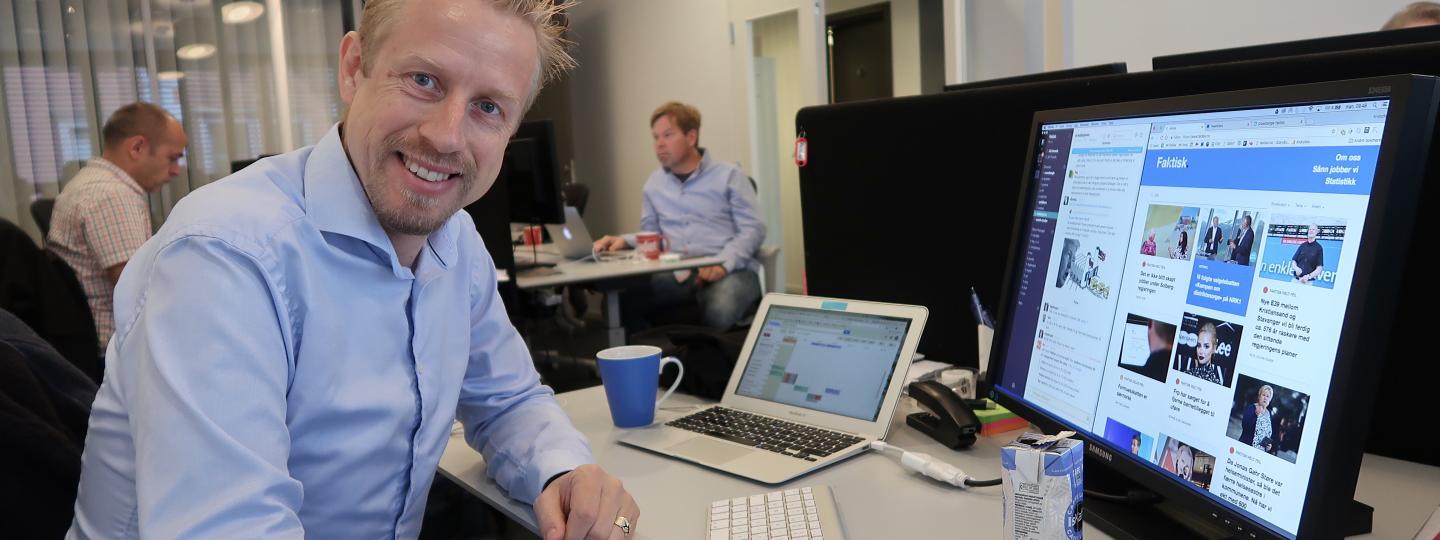Editor's note: This article has been updated with Faktisk's latest traffic numbers.
Last month’s parliamentary election in Norway looked almost nothing like those in France or the U.S. It wasn’t polarized, the ruling bloc stayed in power and there were no big personalities like Donald Trump or Marine Le Pen.
But even during an election with not much more than energy and tax policy at stake, political falsehoods and online misinformation were a prominent feature — and Faktisk was there to combat it.
The Norwegian fact-checking outfit deftly debunked claims by politicians, lead discussions on social media and quickly grew its audience leading up to the election. When all was said and done, Faktisk had become one of the most popular sites in the country — once even surpassing the social media engagement of a false claim it debunked.
Not bad for a fact-checking organization that’s only three months old.
“In only a matter of days, we went from being nothing before we launched to being something a lot of people spoke about,” said Kristoffer Egeberg, editor of Faktisk. “We became an actual factor in the election very quickly, where people came to us, politicians started correcting themselves … this was quite exciting to see.”
Faktisk, Norwegian for both "actually" and "factually," launched in early July with the backing of four of Norway’s biggest news organizations — VG, Dagbladet, NRK and TV 2. As Poynter reported in March, it’s a bit like if The New York Times, The Washington Post and PBS launched a fact-checking project together.
With a shifting daily staff between six and nine people, Faktisk operates as a separate nonprofit organization but receives more than 50 percent of its annual budget from its partners to fact-check claims online. Politics are the outlet’s bread and butter.
“We started about two months before the election with the whole thing, and obviously politics would be the big thing to fact-check,” Egeberg said. “Norwegian politicians are used to being challenged by the media, of course, but fact-checking was something new and different, I think.”
All of Faktisk’s fact checks use a five-point scale ranging from absolutely true to absolutely false, and are free for anyone to use via embed. More than 10 newspapers and organizations regularly run the fact checks natively, while more than 20 have used them at least once, Egeberg said. Once embedded, the fact checks carry over the original formatting from Faktisk, as well as any corrections that are made.
Having content that’s free to share has broadened the organization’s distribution network while also giving local and specialized outlets relevant content to use — a key part of Faktisk’s growth strategy.
“We get an enormous reach compared to what we would if we were just standing alone,” he said. “We’ve gotten actually more traffic on our embeds than our actual site, which is really cool.”
That proved especially true leading up to the election. Since it launched in July, the organization's site has had more than 400,000 unique visitors and more than 1 million pageviews on its 81 fact checks. But Faktisk's embeds have had twice as much traffic as its site, with almost 900,000 uniques and 2 million pageviews — numbers that have landed it with VG and Dagbladet among the most shared sites in the country, according to a screenshot of Storyboard, an online dashboard that monitors social media shares in Norway.
“We’ve had more than 1 million pageviews and more than half a million unique visitors on the embed platform (since we started),” Egeberg said, “which is 1 million pageviews and half a million unique visitors we wouldn’t have if we didn’t have our sharing philosophy.”
Given the numbers, Faktisk’s distribution model seems to be working — and it’s largely alone in providing full-story embeds for free use. Bente Kalsnes, an associate journalism professor at the Oslo and Akershus University College of Applied Sciences, told Poynter that she hadn’t heard of any other news organizations using comparable technology, and that many Norwegians have taken interest in Faktisk’s debunking methods over the past few months.
But despite Faktisk’s relative youth, Kalsnes isn’t surprised it has received a substantial amount of traffic and engagement since its inception.
“This is a service that is used by these four largest media organizations in Norway,” she said. “I think it’s natural for them to have traffic of a lot users because they’re featured on these sites.”
Since VG, Dagbladet, NRK and TV 2 own Faktisk, they frequently use its fact checks on their own sites, which — when coupled with referrals from other embeds — helps amplify the fact checks. When an anti-immigration website published a false claim last month alleging that former prime minister Gro Harlem Brundtland hadn’t paid taxes in years by claiming residency in France, Faktisk quickly debunked it. Then, its fact check skyrocketed to the top of StoryBoard — leaving the original story in the dust (see screenshot below).
“This false story was posted early in the morning and quickly went to the top of the trend list for social media stories,” Egeberg said. “Within 24 hours, our story was shared and had a reach twice as big as the false story. The false story started dropping immediately when we posted our story.”

Faktisk’s relatively short-term success has some key takeaways for fact-checkers around the world: Try to share your fact checks for free, explore new distribution strategies and work with established media organizations to improve your resources.
But in Norway, the influence of fact-checking may be short-lived.
Egeberg said Faktisk’s audience has still shown interest in fact-checking since the election, with one story breaking an institutional record for traffic in the days afterward. Now Faktisk is moving away from debunking political claims and more toward checking fake news and viral hoaxes — but the potential for long-term growth comes down to whether or not they’ll receive consistent funding, he said.
Despite the challenges, the interest in fact-checking is there — and Faktisk has the tools to capitalize on it, Kalsnes said.
“The kind of methods they are developing, and also the technology they’re using, is going to be a big advantage in the months and years ahead,” she said. “This is very much more integrated in the Norwegian journalism ecology in the sense that people are getting more used to it.”
Clarification: This article has been updated to reflect that Faktisk's day-to-day staff varies between six and nine — not 13, as previously reported — while 15 people total have worked on the project.







